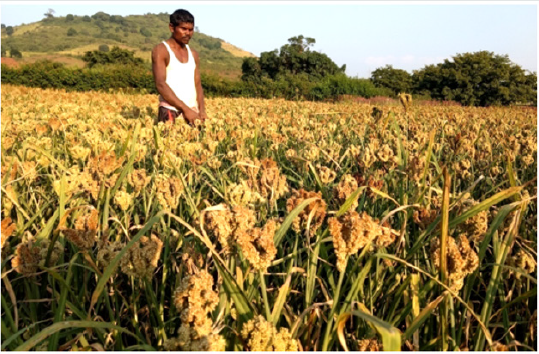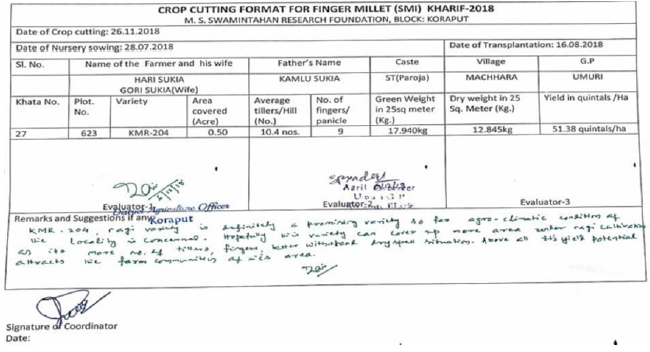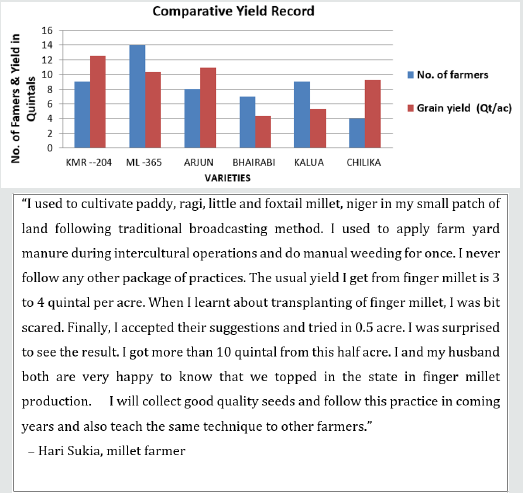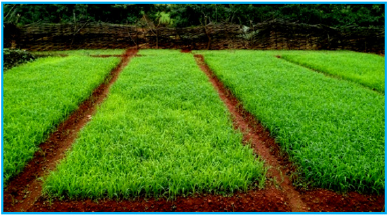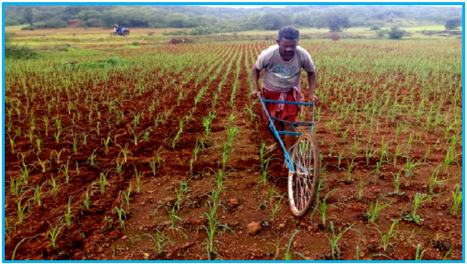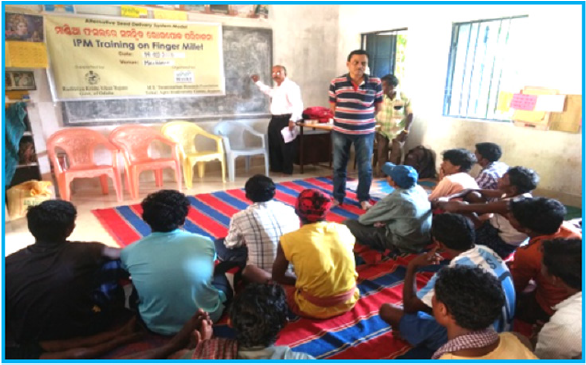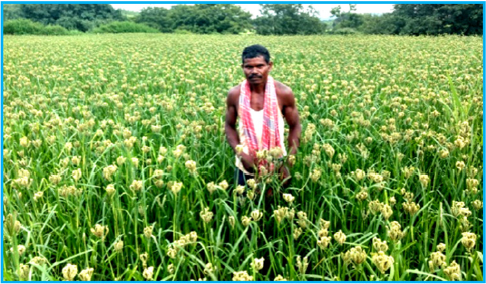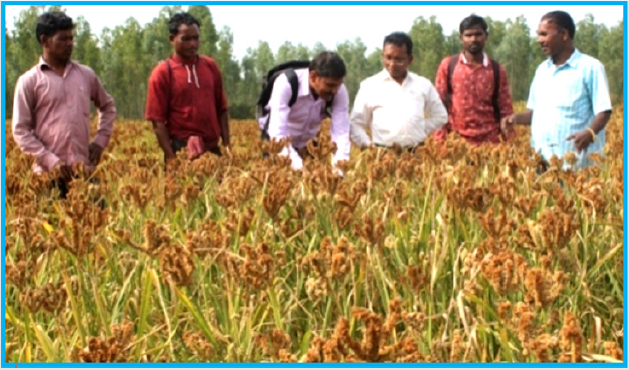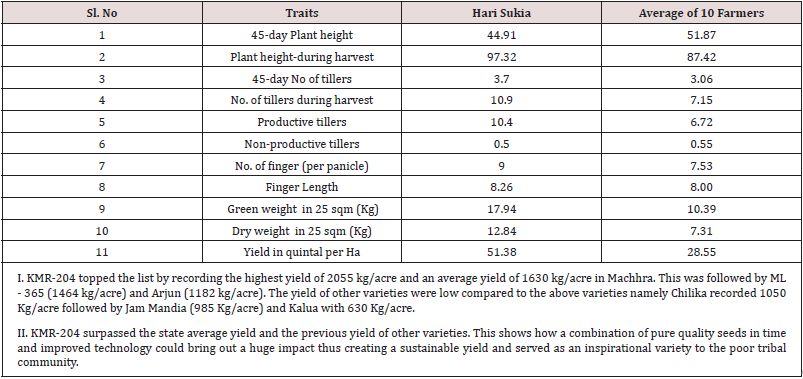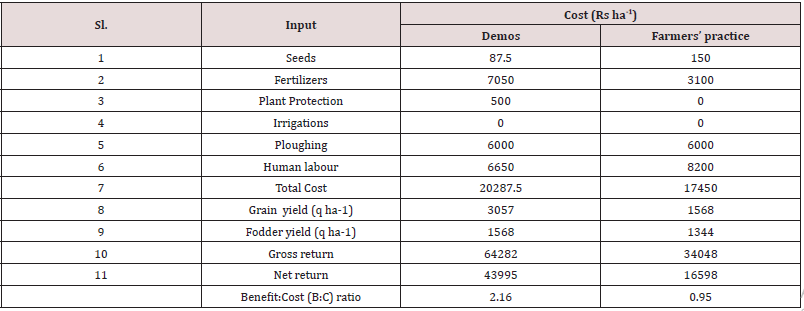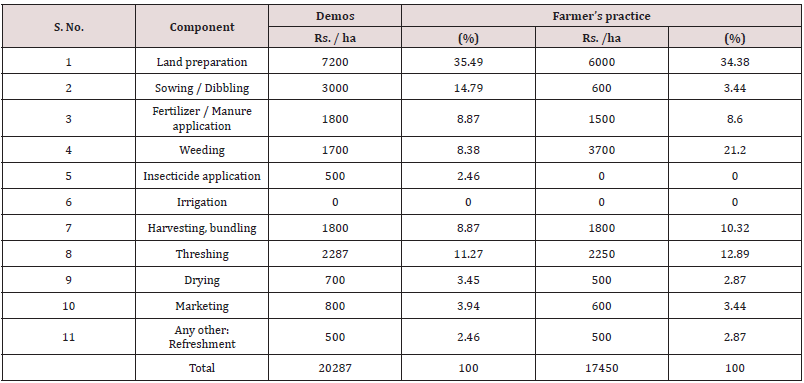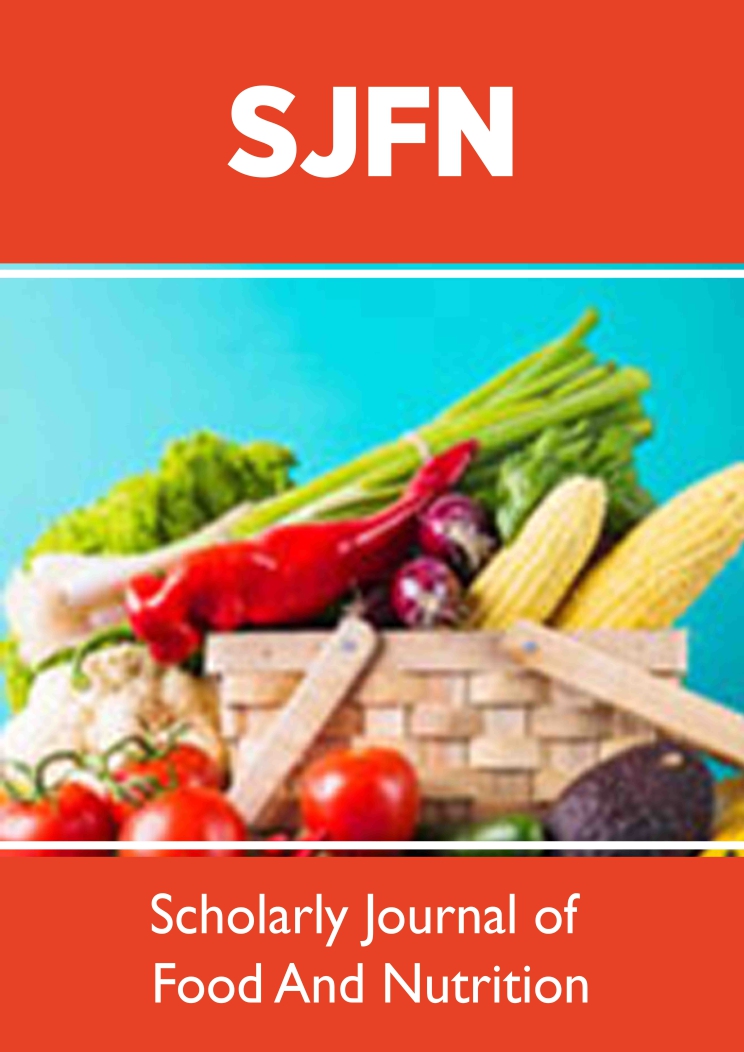
Lupine Publishers Group
Lupine Publishers
Menu
ISSN: 2638-6070
Research Article(ISSN: 2638-6070) 
Magical Hands of a Tribal Farmer Set a Milestone in Finger Millet Cultivation-A Case from Koraput, Odisha, India
Volume 2 - Issue 4Prashant K Parida*, Neeranjan Gauda, Jeeva R and Kartik Charan Lenka
- Senior Scientist in M S Swaminathan Research Foundation, India
Received: February 03, 2020; Published: February 12, 2020
*Corresponding author: Prashant K Parida, Senior Scientist in M. S. Swaminathan Research Foundation, India
DOI: 10.32474/SJFN.2020.02.000144
Abstract
The nutritious millets traditionally occupied substantial part of the diets and cropping systems in tribal areas of Odisha. Millets require less water and are more resilient to climate vulnerability. They can also be cultivated on the undulating terrain. Reduction in millets resulted in nutrition deficiency. In order to address growing crop failures and nutritional issues, millets need to be revived. Majority of the farmers in Koraput district of Odisha are tribal, resources poor and mostly dependent on onset of monsoon for agriculture. The rainfall in this region is erratic and prolonged drought conditions are common occurrences. Numbers of rainy days were decreased over the period of time. Millets being climate resilient crops systems, revival of millets will enhance resilience of the farming systems and household food security against Climate Change. Finger millet is the second staple food after rice. Area under millets is drastically declining resulting in narrowing of the food diversity in consumption at household level. Increasing urban demand, improvements in processing machinery, availability of improved cultivars, better agronomic practices and possibility of accessing support irrigation has increased the potential of realizing higher productivity in millets thereby improving nutrition security, resilience and economic security of tribal households. The farmers were cultivating many traditional varieties in the past, but now have changed to improved varieties because the traditional varieties continuously perform low in terms of productivity due to mixture of seeds, loss of purity and long duration. This paper analyses how a tribal family set a milestone in finger millet by adopting improved agronomic and good agricultural practices (Figure 1).
Keywords: Cropping System; Nutrition Deficiency; Climate Resilient Crop; Koraput; Seeds
Introduction
Odisha is predominantly an agricultural state with a cultivated area of 90.54 lakhs ha and average production of 25.44 million tons. Koraput district comes under Eastern Ghats high land type agroecological zone. The district enjoys tropical climate characterized by hot summer (20.5°C to 38°C), cold winters (12 °C to 29 °C and rainy seasons (19 °C to 28 °C). The winter season generally commences from late November and continues up to the end of February. The summer season commences from March and continues till middle of June. It is observed that about 80% of the total annual rainfall takes place due to south-west monsoon between the middle of June and mid-October. The north east monsoon gives erratic and insufficient rainfall. The average annual rainfall varies between 1320-1520mm (Figure 2 & 3). Although the district is having high rainfall, the number of rainy days is restricted to 70-80 days/ annum. The district is drought prone because of the erratic and uneven pattern of rainfall. The entire Koraput district has a unique physiographic set up. Except the north western and west-west central part, the rest of the district is occupied by dense forest with highly rugged mountains, interspersed with intermundane valleys. The total geographical area is 8,807 Sq. Km. The population of Koraput district as per 2011 census 1,379,647 of which male and female were 678,809 and 700,838 respectively with the schedule caste population is 196540 (14.2.%) and schedule tribe population 697583 (50.6%). The literacy percentage of the district is 49.29 as against 72.9 of the state. Population density is 157/km2. The proportion of district population to the Odisha state population is 3.29%, Sex Ratio (Per 1000) 1032: 999. The total cropped area is about 3.56 lakh ha out of which 1.53 lakh ha (43.0% of TCA) is irrigated and 2.03 lakh ha (57.0% of TCA) is under rain fed area. The main sources of irrigation are canals, rivers, farm ponds, dug wells to net sown area of the district. Among the different crops, cereals accounts for 54.5% of the irrigated area followed by other crops (34.6%), coarse cereals (4.7%), horticulture & plantation (2.9%), pulses (2.5%) and oil seed crops (0.7%). The primary source of income is from Agriculture whereas secondary source from agriculture labourer and daily wages. Kharif is the major cropping season where farmers cultivate cereals, millets and pulses. In Rabi season few pulses crops, oil seed crops and vegetables are being cultivated and majority of the farmers migrated in search of wage labourer both within the district and outside the district. The majority of farmers hold less than one hectare of land in the district and generally practice subsistence farming. Rice is the major crop cultivated in the district in Kharif and also in Rabi where irrigation facilities available. Traditional farm practices are followed in upland resulting in low level of production. In the non-agriculture season NTFP like kendu leaf, tamarind, Mohua and Sal seeds are the source of income. Koraput was recognized as a Globally Important Agricultural Heritage Systems (GIAHS) by FAO in 2012 for the efforts of the community in biodiversity conservation, food security, preserving the traditional wisdom and cultural diversity of the region for the benefit of the present and future generations (Figures 4-6).
Koraput is a tribal dominated district in Odisha consisting of more than 70% small and marginal farmers and 83% of population live in Below Poverty Line (Anonymous, 2013). The most dominant tribes in this proposed operational area are Bhumia, Gadaba, Paroja and Kandha. Subsistence farming still remains their main source of livelihood, supplemented by forest collection and earning wages [1]. The tribal income is mainly based on agriculture and forest products. The per capita income of the district is Rs 25161/ annum (source: Odisha Economic Survey 2014-15). Though the district is rich in biological resources, experienced & hard working farming communities, existence of Women Self Help Groups and the standard of living is quite low due to poor farm productivity, lack of village level small scale industries, low level of technological knowhow and lack of market knowledge. Foreseeing the sustainable yield in finger millet, M. S. Swaminathan Research Foundation launched a project on “Enhancing Production and Productivity of Millets and Pulses in Odisha through an Alternative Seed System Model for Production and Supply of Improved Seed Varieties” with support from Department of Agriculture & Food Production, Govt. of Odisha and Govt. of India under the scheme Rastriya Krishi Vikash Yojana (RKVY) in April 2018. The project was executed in 13 villages of Umuri, Mastiput, Padampur and Lankaput Gram Panchayat in Koarput district involving around 750 farmers. The project introduced new technology like System of Millet Intensification (SMI) and line transplanting. Participatory Varietal Selection was conducted with six traditional varieties and five improved varieties of finger millet. The farmers observed that among all the varieties cultivated, KMR-204 performed better in terms of no. of productive tillers, size of panicle, fingers per panicle, grain filling percentage and grain yield (Figures 7 & 8).
Materials and Methods
Hari and Gori used to cultivate finger millet in one acre of land following traditional practices. They used to follow broadcasting method. Weeding also was a very tedious task for them. They used to harvest 2.5 to 3.0 quintals from it. During last Kharif MSSRF implemented the seed production programme in the village. They were trained on various improved agronomic practices and System of Millet Intensification (SMI) method of cultivation such as - land preparation, FYM application, seed treatment, raised bed nursery preparation, transplanting in SMI method, organic manure and bio pesticides preparation and application, use of cycle weeder for weeding etc. Shri and Smt. Sukia were provided with 500 grams of breeder seed of KMR-204 variety to cultivate in half acre land. Initially they were little bit scared [2]. So, they decided to try in half acre and the rest half acre they cultivated their own variety Bati Mandia following traditional method. They followed all the recommended agronomic practices stated above and also followed organic way of cultivation. They also prepared NPM like Amrut jal, jeebamrut, handi kahata etc. and applied in their millet field in every 15 days interval after weeding using cycle weeder which helped in plant growth and controlling pests and diseases (Figures 9 & 10).
Study Design
A case study
Study Location
Machhara village of Koraput block, Koraput District, Odisha, India
Duration of study
June 2018 to December 2019
Results and Discussions
Despite the un-conducive weather condition during last kharif season, the crop performed very well. There were productive tillers in a range of 8 to 25 per hill. An average finger per panicle was around 9 which is higher than that of other farmers cultivating same variety (Table 1). Hari and his wife were very happy and surprised to see the crop performance of the new improved variety in comparison to her own traditional variety. They yielded 3.4 quintals/ acre from their own variety of bati mandia following traditional practices and 20.55 quintals/ acre from the improved variety i.e. KMR-204 following SMI method and improved cultivation practices (Table 2 & 3). They never dreamt of getting such a bumper yield from the improved variety. Now she is convinced that she will use the seeds of this variety in coming years and also say others to follow the same practice. She sold the foundation seeds of 400 kg @ Rs 40/- per kg and shared around 250 kg to her relatives for seed purpose and remaining grains she kept for own consumption (Figure 11). The cultivation cost was around Rs 6200/- INR for half acre. The net benefit she got after meeting all the cost of cultivation was Rs. 27,400/- INR from the same land of half acre (Table 4-6).
Figure 11: Weighment of finger millet pods during CCE (25 Sq. meter) in presence of District Agriculture Officer, Koraput and staff of MSSRF at Hari and Gori Sukia’s field of KMR-204, (Green weight: 17.940KG and Dry weight: 12.845Kg), Yield/ha = 51.38 quintal.
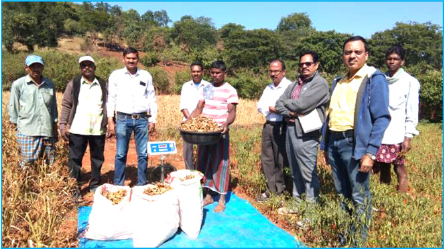
Conclusion
The study clearly reveals that millet is not a poor man’s crop. If it is cultivated with proper care in up or medium land following improved agronomic practices, it can compete with any other crop and produce good yield with very low input cost of cultivation. Inclusion and promotion of modern technological intervention like SMI is an advantage to the finger millet. So, it is proved that millet cultivation can be a viable alternative and sustainable option for the rural poor. Moreover, it is eco-friendly and improves food security and enhances economic growth. She is now a role model who can serve to the community by extending her knowledge and experience to promote millet in the region with a new hope.
Acknowledgement
The authors sincerely thank Department of Agriculture & Food Production, Govt. of Odisha and Govt. of India, RKVY team who supported us to implement this project. Our special thanks are due to Dr Krishnakumar K. Navaladi, Director, Biju Patnaik Tribal Agro-biodiversity Centre, MSSRF, Jeypore for motivation. Special mention of appreciation goes to the farmers of Koraput block who co-operated and adopted the technology and staff members and volunteers who guided the farm families in implementing this alternative seed system project successfully.
References

Top Editors
-

Mark E Smith
Bio chemistry
University of Texas Medical Branch, USA -

Lawrence A Presley
Department of Criminal Justice
Liberty University, USA -

Thomas W Miller
Department of Psychiatry
University of Kentucky, USA -

Gjumrakch Aliev
Department of Medicine
Gally International Biomedical Research & Consulting LLC, USA -

Christopher Bryant
Department of Urbanisation and Agricultural
Montreal university, USA -

Robert William Frare
Oral & Maxillofacial Pathology
New York University, USA -

Rudolph Modesto Navari
Gastroenterology and Hepatology
University of Alabama, UK -

Andrew Hague
Department of Medicine
Universities of Bradford, UK -

George Gregory Buttigieg
Maltese College of Obstetrics and Gynaecology, Europe -

Chen-Hsiung Yeh
Oncology
Circulogene Theranostics, England -
.png)
Emilio Bucio-Carrillo
Radiation Chemistry
National University of Mexico, USA -
.jpg)
Casey J Grenier
Analytical Chemistry
Wentworth Institute of Technology, USA -
Hany Atalah
Minimally Invasive Surgery
Mercer University school of Medicine, USA -

Abu-Hussein Muhamad
Pediatric Dentistry
University of Athens , Greece

The annual scholar awards from Lupine Publishers honor a selected number Read More...




